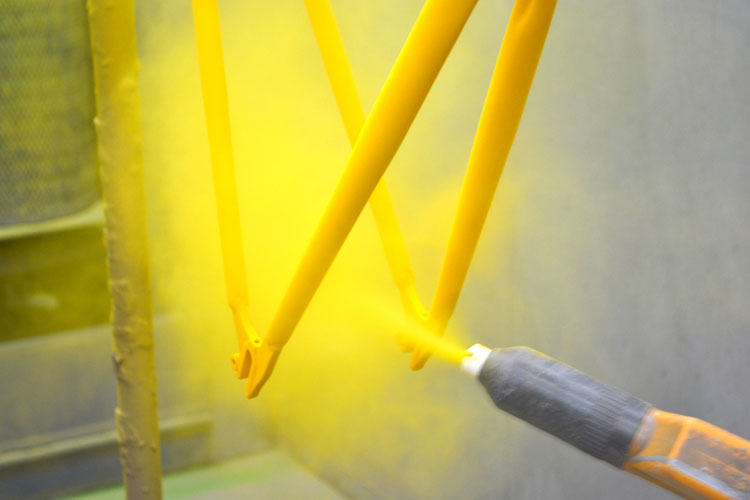Powder coating is a process by which electrostatically charged powder is applied onto an earthed object.
Spray painting and powder coating are carried out in a variety of industries. For example, items that are commonly spray painted include motor vehicles, buildings, furniture, white goods, boats, ships, aircraft and machinery.
Exposure to hazardous chemicals is a significant risk in spray painting and powder coating activities, including during preparation (preparing surfaces, tinting, mixing and pouring paints), storage, clean-up and disposal.
The hazardous chemicals that workers may be exposed to include paints, solvents, powders, lacquers, paint strippers, adhesives, surface preparation products, rust converters and rust removers.
The health effects that a worker may experience following exposure to hazardous chemicals can become apparent after a short period of time and include headaches, nausea or vomiting, dizziness, burns to the skin or eyes and irritation to the nose, throat and lungs. Serious long term health effects where the symptoms may not be immediately apparent can also occur. Long term health effects include asthma, dermatitis, kidney or liver damage, cancer and damage to the reproductive system and central nervous system.
The main risks involved in powder coating arise from the possibilities of dust explosion, fire electric shock, and exposure to hazardous materials. Processes which involve mixing air and combustible organic powders can be dangerous.
A dust explosion may take place when both, the concentration of powder in the air is above the lower explosive limit (LEL) and a source of ignition with the required degree of energy is present at the dust cloud; such sources of ignition can be hot surfaces, open flames, electrical or electrostatic discharges.
Powder Paint Dust is Combustible and is an Explosion Hazard:
When most people think of controlling dust in the workplace, they think of taking steps to avoid inhaling dusts to prevent health problems. However, the accumulation of combustible dusts in the workplace can lead to far greater consequences. As seen in recent years, neglect of housekeeping and improper handling of combustible dusts can lead to property damage, injuries and loss of life.
Powder paints used in powder coating processes are usually combustible and the accumulation
of powders or dusts could lead to a major dust explosion. Consider surfaces that are out of sight where dust may accumulate and ensure such areas are regularly inspected and cleaned.
The National Fire Protection Association (NFPA) defines a combustible dust as “a combustible particulate solid that presents a fire or deflagration hazard when suspended in air or some other oxidizing medium over a range of concentrations, regardless of particle size or shape.” In general, combustible particulates having an effective diameter of 420 μm or smaller, as determined by passing through a U.S. No. 40 Standard Sieve, are generally considered to be combustible dusts. However, agglomerates of combustible materials that have lengths that are large compared to their diameter (and will not usually pass through a 420 μm sieve) can still pose a deflagration hazard. Therefore, any particle that has a surface area to volume ratio greater than that of a 420 μm diameter sphere should also be considered a combustible dust. The vast majority of natural and synthetic organic materials, as well as some metals, can form combustible dust. The NFPA’s Industrial Fire Hazards Handbook states, “any industrial process that reduces a combustible material and some normally non-combustible materials to a finely divided state presents a potential for a serious fire or explosion.”
Suggested Industrial Vacuums for Recovery of Toxic & Combustible Dust
PrestiVac HEPAPlus* Vacuums are specifically designed to safely vacuum toxic dusts. Equipped with a Certified Absolute HEPAPlus*filter with an efficiency of 99.995% on 0.2 micron so there is no risk of exposure or contamination for the operator or the environment. These vacuums are tested for absolute filtration. Testing Method: IEST RP-CC034.3. H14. MIL-STD 282 / A.S.T.M. - D2986-91. MPPS method EN 1822.
PrestiVac Explosion Proof/Dust Ignition Protected Vacuums are designed to safely vacuum explosive, flammable, combustible conductive* dusts. Our Explosion Proof/Dust Ignition Protected Vacuums are completely grounded and static dissipating because they are built entirely with non-sparking metals and do not have any painted components so there is no risk of fire or explosion from a spark or static build up. All the electrical components, including the motor and starter are totally enclosed so there is no source of ignition. Our explosion proof vacuum cleaners comply with NFPA 484 guidelines and are an effective tool for good housekeeping practise as per OSHA.
Which Industries are at Risk with Powder Coating?













